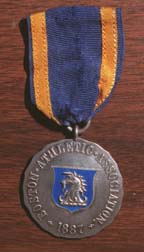 The BAA officials designed the current course to match the original in Greece: a 25-mile hilly route culminating at a stadium, or the closest thing to a stadium that Boston had at the time, the 220-yard Irvington Street Oval.
The BAA officials designed the current course to match the original in Greece: a 25-mile hilly route culminating at a stadium, or the closest thing to a stadium that Boston had at the time, the 220-yard Irvington Street Oval.
At exactly 12:19 p.m., 18 men leaped from the starting line in front of Metcalf's Mill in Ashland (since 1924, the race has begun at Hopkinton Green). The starting official had no gun; he simply shouted "Go!" to start the BAA marathon.
In the early years, runners endured the narrow and dusty dirt roads winding their way to Boston. Today, of course, the roads are wide and paved.
|
The starting line was pushed backward along Pleasant Street and onto High Street, where it rested on the Boston and Albany railroad bridge. The 22-foot wide bridge was more than adequate to handle the 17 starters that year.
By 1907, the bridge could not accommodate the 124 runners. Repairs that year closed the bridge, so the starting point was moved again, onto Union Street at Steven's Corner.
In 1924, the course was lengthened to 26 miles, 385 yards. With that change, the start left Ashland forever, moving up the road and across the town border into Hopkinton.